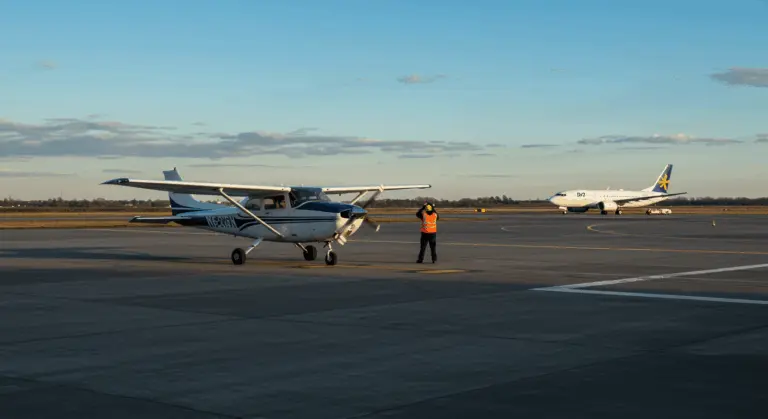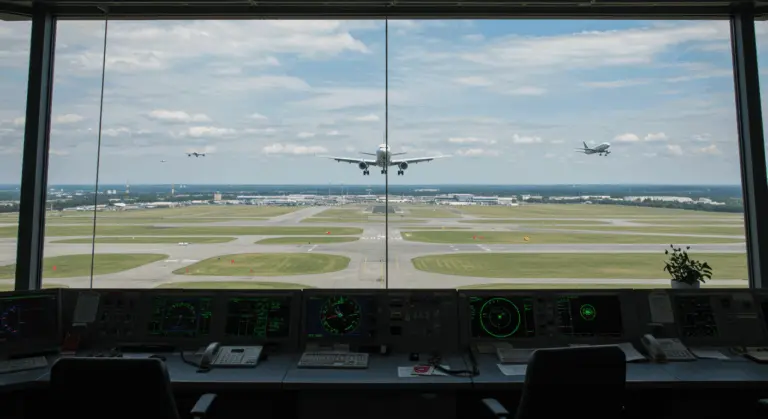How to Calculate VDP – A Comprehensive Guide
Understanding the Visual Descent Point (VDP)
The Visual Descent Point (VDP) marks a specific location on the final approach course of a non-precision straight-in approach. From this point, a pilot who has acquired the necessary visual references can initiate a normal, stabilized descent from the Minimum Descent Altitude (MDA) to the runway—typically following a standard 3-degree glide path.
Approach charts mark the VDP with a distinctive bold letter ‘V’ on straight-in non-precision approaches. This marker identifies the optimal transition from instrument flight to visual landing. Without this calculated reference point, pilots face a dangerous dilemma: descend too early and risk terrain collision, or descend too late and create an unstable approach that may result in a missed approach or runway overrun.
The VDP serves as an important safety tool, standardizing the final phase of non-precision approaches that lack the vertical guidance inherent in an ILS (Instrument Landing System). By providing a specific point for initiating visual descent, the VDP enables pilots to maintain a stable approach profile while eliminating the hazardous “dive and drive” technique—where pilots rapidly descend to MDA, then fly level until visual references materialize.
How to Calculate VDP for Non-Precision Approaches
Understanding Visual Descent Point (VDP) calculations is essential for executing safe, stabilized descents to landing. While many approach charts include a published VDP (that distinctive bold ‘V’), pilots must understand the calculation process for those occasions when it’s absent or requires verification.
The most widely employed formula for VDP calculation relies on a standard 3-degree glide path angle:
Visual Descent Point = Height Above Touchdown (HAT) ÷ 300 feet
This simple formula gives the distance in nautical miles (NM) from the runway threshold where descent from MDA should commence. Consider this example: with a HAT of 600 feet, your VDP sits approximately 2 NM from the runway threshold (600 ÷ 300 = 2).
VDP Calculation Methods – Time and DME
When determining the Visual Descent Point (VDP), pilots can leverage two practical methods based on available instrumentation: the DME method and the time method. Both techniques help pinpoint when to initiate a normal descent from MDA, ensuring a stabilized approach.
The DME (Distance Measuring Equipment) method uses the calculated VDP distance (HAT ÷ 300) to identify the VDP on your aircraft’s DME display. For instance:
-
If your HAT is 450 feet: 450 ÷ 300 = 1.5 NM from threshold
-
If your HAT is 750 feet: 750 ÷ 300 = 2.5 NM from threshold
The DME reading at your VDP equals this calculated distance plus any offset between the DME source and runway threshold. Always verify this offset on your approach chart—accuracy depends on it.
The time method is valuable when DME is unavailable or when you need backup verification. To use this approach:
-
Calculate your ground speed on final approach (accounting for wind)
-
Convert your ground speed to nautical miles per minute (divide by 60)
-
Divide the VDP distance (in NM) by your speed (in NM per minute) to find the time from the VDP to the threshold.
Consider this scenario: you’re flying at 120 knots with a VDP located 2 NM from the threshold:
-
120 knots ÷ 60 = 2 NM per minute
-
2 NM ÷ 2 NM per minute = 1 minute
This means you should initiate descent from MDA approximately 1 minute before reaching the runway threshold. Remember to adjust this calculation for headwind or tailwind components that directly impact your ground speed.
Both methods require practice and sharp situational awareness. The DME method usually provides better precision, while the time method offers a reliable alternative when DME is unavailable. Regardless of your chosen method, always confirm you have the required visual references before descending below MDA. Maintain that stable approach angle throughout your descent to landing.
Factors Affecting VDP Calculation
While basic VDP calculation formulas provide a good foundation, several critical factors can affect the accuracy and applicability of your Visual Descent Point determination. Understanding these variables ensures you make appropriate adjustments for your specific approach scenario.
-
Minimum Descent Altitude (MDA): Since MDA forms the foundation of your Height Above Touchdown (HAT), any MDA change necessitates VDP recalculation. A higher MDA moves the VDP further from the runway.
-
Terrain and Obstacles: Challenging terrain may dictate steeper descent angles or displaced VDPs in published procedures. Always verify your calculation against the approach plate to ensure obstacle clearance.
-
Visibility and Runway Environment: Your ability to acquire crucial visual references—approach lights, runway markings—at the VDP determines success. Poor visibility may delay runway acquisition, making a stable descent from the VDP impossible.
-
Aircraft Performance: Each aircraft’s unique descent rate and speed characteristics shape the descent profile from the VDP. Plan a descent that is comfortable and standard for your aircraft type.
-
Ground speed: Wind directly alters ground speed, consequently affecting available descent time. Headwinds grant additional time for shallower descents; tailwinds compress time, demanding steeper descents.
-
Pilot Technique: Individual comfort levels and experience significantly influence VDP application. However, any deviation must prioritize a stabilized approach over rigid adherence to a calculated point.
Practical Considerations When Using VDP
Using Visual Descent Point calculations in actual flying requires more than mathematical precision—it requires sound judgment and adaptability. When executing a non-precision approach, the VDP serves as a pivotal decision point that can greatly improve both safety and approach stability.
-
Transition to Visual: The VDP represents your optimal transition point from instrument to visual flight. You must rapidly assess whether you’ve acquired the required visual references—approach lights, runway markings—to legally and safely descend below MDA.
-
No Published VDP: When an approach chart lacks that telltale ‘V’, your calculated VDP becomes very important. Determine this point during your pre-approach briefing to reduce in-flight workload.
-
Make a Clear Decision: At the VDP, you face a binary decision: descend or execute a missed approach. Without the required visual references, you must execute a missed approach—no exceptions. Never descend below MDA hoping visual references will materialize later.
-
Maintain a Stable Descent: Once you’ve passed the VDP with visuals acquired, maintain a constant, stabilized descent to the runway. If normal descent rates prove impossible—perhaps you acquired visuals late—a missed approach remains the safer choice, even with the runway clearly visible.
-
Use All Available Aids: Integrate the VDP with complementary visual aids: VAST/PAPI systems for vertical guidance, approach lighting systems for alignment. These tools function synergistically, ensuring a stable visual approach segment.
-
Practice and Prepare: Make VDP calculations a regular component of your pre-flight planning routine. Familiarity with the concept and the numbers for your planned approach builds proficiency and confidence.
VDP and Safety – Avoiding Obstacles
The VDP is important for obstacle avoidance by defining a protected descent path for the final approach segment. By establishing a specific point to begin descending from MDA, it prevents the perilous practice of “ducking under”—premature descent that greatly increases terrain or obstacle collision risk.
Using the VDP properly improves approach stability. Initiating descent at the VDP, rather than maintaining level flight at MDA, enables a constant descent rate. This prevents those steep, unstable approaches that frequently result in hard landings or runway overruns.
At night, the VDP is particularly important for obstacle avoidance. Darkness severely impairs depth perception, transforming unseen obstacles into greater threats. Strict adherence to the VDP provides a predictable, safe descent path that greatly reduces Controlled Flight Into Terrain (FIT) risk.
Conclusion – Mastering VDP Calculations
Understanding the Visual Descent Point is a key element of safe, stabilized non-precision approaches. Whether utilizing a published ‘V’ on your chart or calculating it yourself using the HAT-to-distance rule of thumb, the VDP provides an indispensable decision point. It prevents both dangerously premature descents and rushed, unstable final segments by defining the ideal starting point for a normal 3-degree glide path.
Using the VDP effectively combines calculation with good airman ship. Always confirm required visual references before descending below MDA, and remain prepared to execute a missed approach if they’re not visible at the VDP. By integrating this powerful tool into both pre-flight preparation and in-flight execution, pilots can confidently transform challenging approaches into consistently safe landings.







